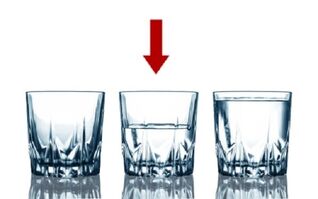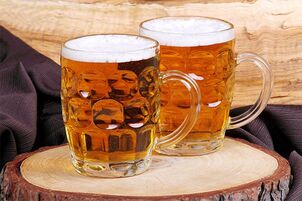Few people know that ethyl alcohol acts on the human body as a poisonous substance. However, this scientifically proven fact does not increase the number of cleaners. Some people drink on major holidays, and those for whom Friday night is already a reason to throw alcohol and do not want to hear about the dangers of alcoholic beverages. Advocating for a healthy lifestyle, doctors have figured out how often you can drink alcohol so that there are no tangible negative consequences for the body.
The article shows the average values. Gender, age, weight, the presence of diseases can change them in one direction or another.
Classification of drinkers in home narcology
Depending on the frequency and amount of alcohol consumption, experts divide people into five groups.
The word abstinence refers to abstinence from anything, including alcohol. Doctors call abstinent people who do not drink at all or drink a glass of champagne several times a year. Often, tooth causes have three reasons to be sober:
- biological - allergy to alcohol, when even the use of a small dose leads to serious poisoning; also ethyl alcohol can cause unusual intoxication when instead of raising the mood appear depression and depression;
- medical - when you can not drink due to illness;
- behavioral - a person has deliberately decided not to drink a single gram of alcohol.

Sometimes some abstainers can drink a little so as not to look rejected in the company of drinking. But the dose of alcohol is very small, so they never get drunk. More often than not, dentists find some reason not to pour at all.
In this category, doctors classify people who consume no more than 250 ml of vodka several times a year, but not more often than once a month. In general, they start drinking in adulthood, observing rituals, but do not get much pleasure from drinking, on the contrary, the next morning after a feast they experience the symptoms of a hangover. Therefore, by the age of forty, they often fall into the category of abstinence and can not even tolerate the smell of fumes.
This is the most controversial group, as there is no consensus on moderate and high doses of alcoholic beverages in the medical environment. Russian narcologists classify a moderate drinker who drinks an average of 100-150 ml of vodka (maximum 400 ml) from 1 to 4 times a month. These people are organizers of parties and meetings with friends, because drinking alcohol for them means improving their mood.
Such people are able to drink 200-300 ml of vodka once or twice a week (maximum 500 ml). Usually their alcoholic experience begins before adulthood and after a few years alcohol occupies an important place in the system of life values. Gradually, a psychological dependence on ethyl alcohol is formed and this indicates the first stage of alcoholism.

According to doctors, this group includes a person who drinks half a liter or more of vodka several times a week. It is difficult for him to suppress the desire to drink, alcohol becomes a priority in life. To achieve a state of intoxication, you need to drink more and more. Constant intake of such doses leads to sleep disturbances, various diseases of the internal organs and personality degradation. As much as doctors want not to spoil the statistics, but things have to be called by their own names, this is alcoholism in the second stage of addiction.
If you recognize yourself in the last two items on the list, it's not too late to stop and stop the progression of the disease. You can begin your journey to a sober lifestyle by taking medications that are freely available on the Internet. They reduce the thirst for alcohol and at the same time help the body get rid of alcohol toxins.
World Alcohol Standards
The World Health Organization has defined a standard serving of alcohol called a beverage or unit. It is equal to the amount of drink containing 10 g of pure alcohol. For example, one drink will be a bottle (330 ml) of beer, 150 ml of dry wine or 45 ml of vodka or brandy.
You can find out the amount of ethanol in other beverages based on the information on the label: displacement and strength in percentage by volume.
Based on this standard, the WHO has developed a recommended and minimizing risk of complications in the form of somatic diseases and alcoholism:
- men are recommended to drink no more than 40 g of ethanol per day, which is equal to 100 g of vodka;
- The daily portion for women should not exceed 30 g of alcohol, ie no more than 80 g of vodka or a glass of wine.

When asked how often a person can drink alcohol, doctors answer that this should not be done every day, even if the dose is only one drink. On the contrary, breaks of at least two days are needed between drinking alcohol.
Safe drinking is a relative term
Guided by the recommendations of respected experts, you must take into account a number of individual factors, based on which even a standard serving once a week can lead to negative consequences for the drinker.
- You should not drink under any pretext for those who are allergic to ethanol or to the components of alcoholic beverages (dyes, flavors), as well as people with chronic diseases of the stomach, liver and other internal organs.
- It is not recommended for people with a genetic predisposition to alcoholism (one of the parents to drink) to start getting acquainted with strong drinks at all.
- There is no such thing as "safe drinking" for adults. Even a hundred grams of vodka, taken once, can cause enormous damage to a still unformed body of a teenager.
- Doctors do not advise pregnant women and nursing mothers to drink, as it is harmful to the baby.
WHO doctors have concluded that the average person can drink 8 liters of alcohol without harm to health for a year. In Russia, statistics show that there is up to 18 liters of alcohol per drinker, ie the norm is more than doubled.
Debunking myths about the safety of low-alcohol beverages should contribute to the promotion of alcohol culture. It is often with beer and cocktails that alcoholism begins in women and adolescents who are convinced that there is no harm from low-grade drinks.
Why is beer so popular?
Many people like that beer contains less alcohol than vodka.
"I drink beer, it's a low-alcohol beverage. Therefore, I have no addiction. "

A person who drinks beer feels that he is not afraid of beer alcoholism.
The man added: "After all, there are people who drink vodka - they are alcoholics, not me. I have no problems. "
However, these beliefs do not justify the alcoholism of a person's beer.
How often can you drink alcohol
New Year without the sound of champagne glasses. Wedding or birthday without toasts. Meeting with friends without 100 grams of vodka or a bottle of beer. Family celebrations with tea only. "Presentations" that do not include a bottle of expensive wine or cognac with significant aging. No, this is not the world after the Apocalypse, this is a simple existence in which no one will drink alcohol. It's hard to imagine that at least some of the events that modern people are used to can happen without alcohol. However, no one will say that you can not drink at all - it is enough just to use strong drinks wisely and not too often (the norm is definitely not every day). You can drink a small amount of beer, vodka or wine without harming your health and with pleasure.
As much as possible
WHO standards define a standard dose of alcohol ("beverage" or "unit") as a serving of alcohol that contains 10 grams of pure (96%) ethanol. There are special tables that allow you to calculate how much ethanol is contained in a particular beverage based on the data provided by the manufacturer (each bottle is provided with information about the number of milliliters (grams) of alcohol and its strength in percent by volume). To simplify these calculations, we can say that the average equivalent of the norm for one dose-drink:
Objections of opponents of beer
With regular and unlimited use, beer causes great damage to the heart: it becomes sluggish, increases in size, the heart cavities dilate, the rhythm is disturbed. Beer contains female hormones, so men who drink beer become feminine over the years, both in appearance and character.
Since getting used to beer is quite a quick process, warn opponents of this drink, sooner or later you will stop thinking about yourself in the company of friends without a bottle of beer; going out into nature without alcohol will become meaningless for you; gradually in life there will be no free time without alcohol.
Sounds scary. But after re-reading the arguments of the supporters, everything again does not look so gloomy. So who is right? Is it good to drink beer or not?
The truth is probably in the middle. If you look closely at the arguments of beer supporters, you will notice that they relate mainly to a small but regular consumption of beer - no more than a bottle per day. If you start drinking this drink in liters, it can not be of any benefit, but small doses 1-2 times a week (actually not every day) can really bring more benefit than harm. And drink only quality beer, preferably freshly brewed and unfiltered - then the benefits will be obvious.
Consumption of alcoholic beverages without harm to health
According to statistics in 2020, Russia ranks 6th in the ten most drinking countries in the world. The average Russian consumes 15. 1 liters of alcohol per year, and the woman - 7. 8 liters. Vodka is the most preferred in our country, but recently the use of wine is also increasing. How often can you drink, what and in what quantities so as not to harm your health? What are the standards and rules for drinking alcohol? Read this article.
It is no secret that the ethanol contained in alcoholic beverages has a harmful effect on the human body, such as poison. And despite the fact that this fact has long been scientifically proven, there is no increase in the world of people leading a sober lifestyle. Most do not even want to hear about the dangers of alcoholism, considering every weekend a reason to drink. However, doctors tirelessly continue to fight for a healthy lifestyle, setting ethanol standards for people who will not be able to negatively affect their health and well-being.Classification of drinkers in home narcology
Experts have divided people into five groups according to the amount and frequency of alcohol tests.
- Abstainers are people who are indifferent or negative about alcohol. The state of intoxication does not give them pleasure, causes physical discomfort or is unacceptable for moral reasons. Abstainers can be absolute, who definitely do not drink alcohol, and relatives who can afford to drink no more than 100 ml of low-alcohol beverages 2-3 times a year. Abstainers from the absolute group are also divided into three types. The first - biological - is allergic to alcohol or discomfort after taking it. The second - medical - strong drinks are prohibited due to the presence of any disease. The third - behavioral - a person deliberately refuses alcohol simply because he has decided so.
Pay attention! Sometimes abstainers can afford a small dose of alcohol, but this is rare. They never get drunk and often find some reason not to drink.
- Coincidentally, drinkers are people who do not want to drink, but can afford to drink up to 250 ml of strong drink no more than once a month. The state of intoxication is weak and does not give them pleasure. Even after drinking so little, these people experience hangover symptoms the next morning. Therefore, at an older age, they often already begin to belong to the abstinence group.
- Moderate drinkers are people who drink up to 400 ml of strong drinks 1 to 4 times a month. Drinkers in this category enjoy being intoxicated and often initiate liberations in the company. In the medical field, there is no unequivocal opinion about high and moderate doses of alcohol, which is why this group is considered the most controversial: the consumption of alcoholic beverages for such people is considered a way to raise their mood.
- Systematic drinkers - people who consume up to 500 ml of alcohol up to twice a week. They use drunkenness as a way to relax, have fun and find common ground with the environment. This category is characterized by alcohol abuse, resulting in a weakening of self-control and behavioral disorders. Such people often experience a hangover after a party and often start drinking from a young age, as a result of which over time they form a psychological dependence on alcohol, so that strong drinks occupy an important place in their lives. Here begins the first stage of alcoholism.
Symptoms of beer alcoholism
I will give you specific symptoms of beer alcoholism
The symptoms of beer alcoholism are:
- One often loses control over drinking beer. (drink more than you should). Loss of control while drinking is the first sign of alcoholism.
- The man himself completely denies the presence of beer alcoholism.
- The addict protects and justifies his drinking in every possible way. It gives a million reasons why he should drink beer.
Read the list below. If you have one or more symptoms, it clearly identifies that you have beer alcohol.
- Your main reason for drinking beer is to relieve tension and relieve stress.
- In sobriety, when you don't drink beer, you're depressed and depressed. They are often irritable, sometimes even aggressive. All this is due to the discomfort of not using.
- You drink beer regularly and constantly (every day or every week).
- You can't just give up beer forever. You can't not use it at all.
In addition to being aware of the presence of beer alcoholism, one must also study the negative consequences in the form of symptoms of alcoholism associated with drinking beer.
Learn to recognize withdrawal symptoms and how to go through the withdrawal period.
Drinking beer in moderation will not work, give up this idea immediately. I wrote about this in the article "Can you drink in moderation? "
Complete unconditional abstinence from drinking beer, like any other alcohol, is a prerequisite for sobriety.
However, this is not enough.
To get rid of beer alcoholism, you need to learn how to avoid the breakdown of alcohol.
Breakdown occurs when your state of mind becomes so negative that drinking beer seems like the only option. What should be done to avoid loosening and drinking beer, I wrote in the article "What is alcohol breakdown and how to avoid it? “
Gaining knowledge about your addiction is paramount to getting rid of alcoholism with beer.

Here's a step-by-step plan on what to do to get rid of beer alcoholism.
- Realize your addiction. Find out how you justify your addiction.
- Learn about the problems caused by alcohol use.
- Learn about the negative effects of alcohol and know the signs and symptoms of alcoholism. You will need to read a lot of information, so tune in to it right away.
- Find out what the sobering process looks like. Stopping drinking is not enough. You can't leave for a day. And you will have to deal with the consequences for more than a month.
- The most important skill you can learn along the way is to learn to avoid slowing down.
- Prerequisite is complete abstinence from drinking beer on the way to sobriety.
If you have questions about beer alcoholism, you can always ask them in the comments.
Alcohol consumption per day
Large doses of alcohol are undoubtedly harmful: they are addictive and provoke the development of chronic diseases. But if you drink, knowing when to stop, you can avoid terrible consequences. The main thing is to correctly calculate the measure itself.
Is there a safe proportion of alcohol
The body, due to the presence of a special enzyme alcohol dehydrogenase in the liver, is able to process a certain amount of alcohol without fatal consequences for health. Everyone has their own speed: it depends on the amount of enzyme, metabolic characteristics, gender and age.
Scientists from the World Health Organization were able to calculate the average safe dose. If you do not exceed the specified volume, then you can avoid alcohol dependence, as well as maintain a healthy liver, pancreas, heart and other organs.
Alcohol per day
It is not possible to calculate your safe percentage outside the laboratory. This indicator depends on many factors. It is best to use average data.
This indicator depends on many factors. It is best to use average data.
For men
A harmless portion for men is 30 ml of ethyl alcohol.If we turn this figure into drinks, it turns out that you can drink a day:
- 90 ml of vodka, cognac, whiskey, brandy or other beverages, strength 40 rpm;
- 225 ml fortified wine or port (alcohol 17-20%);
- 300 ml dry wine or champagne (10-13 degrees); 750 ml of beer (5% alcohol).
At the same time you should drink no more than five times a week and preferably not every day.
For women
The female body due to physical characteristics is more difficult to tolerate alcohol intoxication than the male. Therefore, the numbers for the ladies are a little different. The permitted amount is 20 ml of ethanol per day. But some researchers recommend splitting this figure in two. 10 ml of pure alcohol is 30 grams of vodka or 100 ml of wine. The reason is that women tend to be underweight and also produce less alcohol dehydrogenase. This means that alcohol is more harmful.
How much alcohol can I drink per week
Five drinks a week is the maximum dose for a healthy person. But you should not save them and drink them for one day: the liver will not be able to cope with the weekly norm at once. The likelihood of a severe hangover is high. If you regularly undergo such experiments, it will lead to alcoholism.
When there is no secure sharing
The safe dose is a rather vague concept. So, people with acute or chronic diseases should not drink at all. Any, even the smallest portion of alcohol can react with drugs or lead to complications.
So, people with acute or chronic diseases should not drink at all. Any, even the smallest portion of alcohol can react with drugs or lead to complications.
Also, there is no harmless dose for children and adolescents under 18 years of age. At this age, the body is in the formation stage and drinking has a depressing effect on the brain and nervous system, leading to degradation.
Pregnant women and nursing mothers are another category of people for whom alcohol is extremely dangerous. If the expectant mother consumes alcohol during the prenatal period or breastfeeding, all harmful substances enter the child's body. This leads to serious mental disorders, developmental delays, congenital diseases.
Safe norm for the driver
According to the latest changes, the permissible percentage of alcohol while driving is 0, 35 ppm, which corresponds to 0, 35 grams of alcohol per liter of blood. In order for the average man weighing 70-80 kg to reflect such an indicator, he must drink 25-30 grams of pure alcohol. This is equivalent to a shot of vodka, a glass of wine or two small mugs of beer.
But before driving, you should not experiment even with such an amount: the body may give an unpredictable reaction or the breathalyzer will have an error. Then the driver will face a huge fine or disqualification - too high a price for the dubious pleasure of drinking.
The weathering time must be calculated to ensure that sufficient time has elapsed after use and that it is safe to drive. This can be done using a spreadsheet or online calculator, or you can use a home breathalyzer.
This can be done using a spreadsheet or online calculator, or you can use a home breathalyzer.
Measure
The norm itself, which must be followed mercilessly when drinking alcohol, is different for everyone. You can only recognize it once after drinking. Or sometimes the body itself feels when there is already enough. In this case, do not give in to persuading friends to drink a few more glasses. Otherwise, drinking a lot in the evening, the next day you can say goodbye to an energetic morning, and you will also need to drink at least 3 liters of water and eat 4 anesthetic tablets. Several such parties in a row with a heavy hangover in the morning will bear fruit in a few months. Not only morning problems but also health problems can start. Ethanol poisons almost all body systems, from iodine balance to the liver or heart. This also leads to addiction and as a result the well-known disease alcoholism appears.































